Pioneer Presbyterian Church was established as the result of nearly twenty years of perseverance, determination and faith on the part of our founders. In those early pioneer days, Marinette was a small, rough, sawmill settlement – not only was there no church, but some of the settlers were opposed to the establishment of any church.
In the 1840’s, the Rev. Jeremiah Porter, pastor of the First Presbyterian Church of Green Bay (established in 1836, the first Presbyterian church in Wisconsin), held mission services once or twice a year at the Marinette home of Dr. J.C. Hall, the first local physician.
In 1856, Mr. Porter performed the first marriage ceremony in this community when Henry Bentley wed Dr. Hall’s only daughter, Mary.
In 1857, the Rev. J. W. Donaldson, a Methodist minister from Oconto, moved to Menekaune and formed a small class. He was later ordained as a Presbyterian minister and persuaded the members of his class to become Presbyterians. In 1859 he returned to Oconto, leaving no record of an established church.
In 1862, the Rev. Timothy Hill, district secretary of the New York Missionary Committee, and his family spent part of the summer visiting at Dr. Hall’s home. While in Marinette, Mr. Hill held services at Dr. Hall’s home and promised to help in finding a permanent pastor for the community.
 Mr. Hill told the Rev. John Fairchild of Wabash, Indiana (pictured here) of the religious needs of this little settlement. Mr. Fairchild then wrote to Dr. J.J. Sherman of Marinette, visited Marinette in March 1863 and decided to move here and establish a church. He and his family arrived here on May 22, 1863. Practically all travel to Marinette was by steamboat; it took the Fairchilds from May 9 to May 22 to travel from Wabash, Indiana to Marinette.
Mr. Hill told the Rev. John Fairchild of Wabash, Indiana (pictured here) of the religious needs of this little settlement. Mr. Fairchild then wrote to Dr. J.J. Sherman of Marinette, visited Marinette in March 1863 and decided to move here and establish a church. He and his family arrived here on May 22, 1863. Practically all travel to Marinette was by steamboat; it took the Fairchilds from May 9 to May 22 to travel from Wabash, Indiana to Marinette.
On August 23, 1863, Pioneer Presbyterian Church was organized with Mr. Fairchild as pastor and the following thirteen charter members: Mrs. J.C. Hall, Dr. J.J. Sherman, Mary Bentley, William P. Newberry, Henry Newberry, Mrs. Henry Newberry, Mrs. Lois Emmerson, Daniel Holdredge, Mrs. Frances Holdredge, Mrs. Laura P. Fairchild, Miss Catherine Fairchild, Miss Laura Fairchild and Miss Sarah Fairchild. Mr. Daniel Holdredge, Dr. J.J. Sherman and Mr. William P. Newberry were the first ruling elders. Dr. Sherman continued to serve as a ruling elder until his death on January 9, 1910 – almost forty-seven years later.
Four streets in Marinette still bear the names of our founders: Hall Avenue, Sherman Street, Newberry Avenue and Mary Street, named for Mary Hall Bentley.
The first communion service was held on January 10, 1864, at which time ten more members joined the church on profession of faith.
Services were held in a small schoolhouse in Menekaune until the Union School building in Marinette was completed in 1864. Pioneer Church rented the upper story, which was one large room, and equipped it for a church. The first concert ever given in Marinette was in this upper room for the purpose of purchasing an organ for the church. Also, “the first Christmas tree that delighted the eyes of old and young alike” was in that room. In this upper room Mr. Harlan P. Bird organized the first Sabbath school.
On May 22, 1870, the Pioneer Presbyterian Church was incorporated according to the laws of the State of Wisconsin and the following trustees were elected: Isaac Stephenson, Dr. J.J. Sherman, Wellington White, Henry Bentley, Harlan P. Bird and D. Clint Prescott.
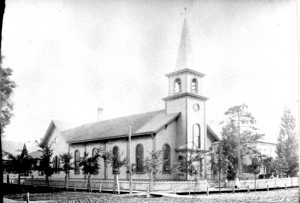 The first church building (right) on the corner of Church Street and Newberry Avenue was completed and dedicated in November 1870 at a cost of about $4,000, the congregation being assisted by the Church Erection Board with a mortgage in the amount of $700. Senator Isaac Stephenson gave the land for the church and for the manse, which was built on Newberry Avenue at a later date.
The first church building (right) on the corner of Church Street and Newberry Avenue was completed and dedicated in November 1870 at a cost of about $4,000, the congregation being assisted by the Church Erection Board with a mortgage in the amount of $700. Senator Isaac Stephenson gave the land for the church and for the manse, which was built on Newberry Avenue at a later date.
Mr. Fairchild resigned in June 1871, after eight years of faithful service. He continued to live in Marinette until his death on April 24, 1885, and is buried in Woodlawn Cemetery. He was known as “Father Fairchild” and was beloved by people of all denominations.
All of the church records were burned in the great fire of October 8, 1871, and the homes of three members of the church were destroyed but, fortunately, the new church was spared.
In September 1871, the Rev. A.J. Buel was secured as stated supply and remained for six months. The church was without a pastor from the time Mr. Buel left until the Rev. George S. Woodhull visited the church in December 1873, received a call, and served as pastor until January 14, 1883. The manse on Newberry Avenue was built for the Woodhulls.
 The Rev. A.V.C. Schenck of Philadelphia was pastor from April 18, 1884, until August 24, 1887, resigning because of failing eyesight.
The Rev. A.V.C. Schenck of Philadelphia was pastor from April 18, 1884, until August 24, 1887, resigning because of failing eyesight.
 The Rev. John Gilbert Blue of Rochester, New York, was called to the pastorate in October 1887 and installed June 15, 1888.
The Rev. John Gilbert Blue of Rochester, New York, was called to the pastorate in October 1887 and installed June 15, 1888.
In 1889 the Bangs Street Mission Chapel was built by the church and a mission Sabbath School established for the fifth ward. The name was later changed to the Bangs Street Presbyterian Chapel. The chapel was sold in July 1904. In 1890 the first pipe organ was purchased at a cost of $1500.
In 1892 there was a Religious Revival in Marinette and in the following year one hundred and eight members joined the church. The elders set up a special committee to advise the converts. Mr. Blue resigned in June 1892.
The Rev. Minot S. Hartwell of Chicago was installed September 21, 1892, and resigned September 15, 1893. He was followed by the Rev. John L. Countermine of Hiawatha, Kansas, who was installed April 18, 1894.
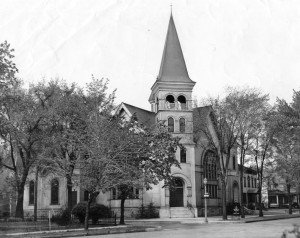 In 1895, the first church was moved and remodeled for Sunday school rooms and a new sanctuary was erected on the corner of Church Street and Newberry Avenue. This new building was dedicated on June 17, 1900, but the entire project was not completed until 1904.
In 1895, the first church was moved and remodeled for Sunday school rooms and a new sanctuary was erected on the corner of Church Street and Newberry Avenue. This new building was dedicated on June 17, 1900, but the entire project was not completed until 1904.
Mr. Countermine resigned on November 23, 1897.
 The Rev. Thomas S. Anderson was installed May 18, 1898, and resigned May 3, 1905.
The Rev. Thomas S. Anderson was installed May 18, 1898, and resigned May 3, 1905.
 The Rev. Sherman L. Divine of Chicago was installed October 25, 1905.
The Rev. Sherman L. Divine of Chicago was installed October 25, 1905.
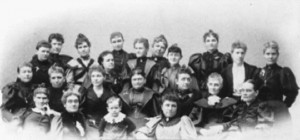 During this early period, Pioneer Presbyterian Church did considerable home mission work in Marinette County. Several mission churches and Sabbath schools were established. (Pictured left are several members of the Women’s Mission Society, circa 1898). Pioneer has always been a missionary-minded church. The Rev. Fairchild conducted mission services in Menominee until the First Presbyterian Church was established there in 1868. In 1889, the Bangs Street Presbyterian Chapel, a mission Sunday school for the fifth ward, was erected and maintained until 1904. There was also a mission Sunday school in Menekaune. As Marinette County grew, Pioneer established mission Sunday schools and mission churches out in the county, known as “substations.” The following present day churches were established during that mission period: First Presbyterian Church, Wausaukee; First Presbyterian Church, Amberg; and Faith Presbyterian Church, Crivitz.
During this early period, Pioneer Presbyterian Church did considerable home mission work in Marinette County. Several mission churches and Sabbath schools were established. (Pictured left are several members of the Women’s Mission Society, circa 1898). Pioneer has always been a missionary-minded church. The Rev. Fairchild conducted mission services in Menominee until the First Presbyterian Church was established there in 1868. In 1889, the Bangs Street Presbyterian Chapel, a mission Sunday school for the fifth ward, was erected and maintained until 1904. There was also a mission Sunday school in Menekaune. As Marinette County grew, Pioneer established mission Sunday schools and mission churches out in the county, known as “substations.” The following present day churches were established during that mission period: First Presbyterian Church, Wausaukee; First Presbyterian Church, Amberg; and Faith Presbyterian Church, Crivitz.
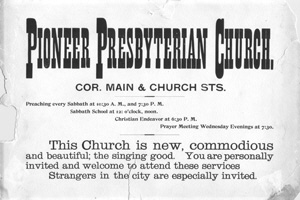 FROM CHURCH MANUAL OF 1907
FROM CHURCH MANUAL OF 1907
Summary of Work March 31, 1907
Mission Stations organized in the County…………………..7
Churches organized in the County……………………………2
Members received in Out-stations…………………………..56
Members received in Pioneer Church…………………….230
Active membership……………………………………………514
Total membership……………………………………………..646
Sabbath School membership………………………………..593
![]() The Rev. Thomas A. Graham of Waukesha was installed June 14, 1940.
The Rev. Thomas A. Graham of Waukesha was installed June 14, 1940.
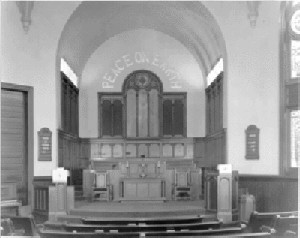 The beautiful Francis G. Hood Memorial Chancel, a gift from the family of Mr. Francis G. Hood, and the rebuilt organ were dedicated on Sunday morning, June 28, 1942.
The beautiful Francis G. Hood Memorial Chancel, a gift from the family of Mr. Francis G. Hood, and the rebuilt organ were dedicated on Sunday morning, June 28, 1942.
![]() Mr. Graham resigned December 2, 1944, and we were without a regular pastor until the Rev. Willard W. Strahl of Philadelphia (pictured left) was installed on February 14, 1946. Mr. Strahl resigned September 29, 1951.
Mr. Graham resigned December 2, 1944, and we were without a regular pastor until the Rev. Willard W. Strahl of Philadelphia (pictured left) was installed on February 14, 1946. Mr. Strahl resigned September 29, 1951.
The manse on Newberry Avenue had been torn down after Mr. and Mrs. Graham left; later a house across from the church at 1388 Merryman Street (still standing) was purchased for use as the manse. This house served as the manse until 1960.
 The Rev. Axel Pearson, a retired Methodist minister, was our pulpit supply until February 1953. the Rev. Gifford R. Ruby of Detroit was installed February 10, 1953.
The Rev. Axel Pearson, a retired Methodist minister, was our pulpit supply until February 1953. the Rev. Gifford R. Ruby of Detroit was installed February 10, 1953.
 The Rev. Gifford R. Ruby was installed February 10, 1953. He and his family lived at 1388 Merryman Street until 1960 when the home of the late Dr. and Mrs. E.H. Redeman at 326 State Street, which had been willed to the church, became the manse and the Merryman Street property was sold.
The Rev. Gifford R. Ruby was installed February 10, 1953. He and his family lived at 1388 Merryman Street until 1960 when the home of the late Dr. and Mrs. E.H. Redeman at 326 State Street, which had been willed to the church, became the manse and the Merryman Street property was sold.
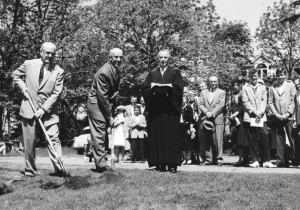 In 1955, a building fund committee was elected to study the cost of building a Christian education building and a building fund campaign was authorized. The original plan was to build the education building adjoining the old church at Newberry and Church Street, but after much discussion and careful consideration of future needs, it was decided to find a new location for both the Christian education building and the church.
In 1955, a building fund committee was elected to study the cost of building a Christian education building and a building fund campaign was authorized. The original plan was to build the education building adjoining the old church at Newberry and Church Street, but after much discussion and careful consideration of future needs, it was decided to find a new location for both the Christian education building and the church.
A building committee was elected. The Riverside property was purchased in the spring of 1957 and the ground-breaking ceremony for the Christian education building took place June 15, 1958.
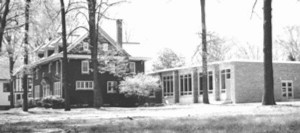 The new Christian Education building was completed in the spring of 1959 at a cost of about $150,000. The last service in the old church was on April 26, 1959. The old church was torn down later that year and the property sold. The Thielen Funeral Home now stands on the former church location.
The new Christian Education building was completed in the spring of 1959 at a cost of about $150,000. The last service in the old church was on April 26, 1959. The old church was torn down later that year and the property sold. The Thielen Funeral Home now stands on the former church location.
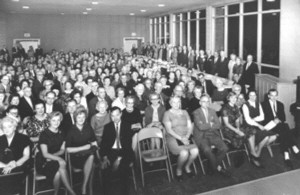 Dedication of the Christian Education Building took place Sunday afternoon, May 24, 1959. Since the old church building at Newberry and Church Street had been torn down, worship services (note the organ console right-center of photo) were held in the C.E. building until our present church building was finished at 1947 Riverside Avenue.
Dedication of the Christian Education Building took place Sunday afternoon, May 24, 1959. Since the old church building at Newberry and Church Street had been torn down, worship services (note the organ console right-center of photo) were held in the C.E. building until our present church building was finished at 1947 Riverside Avenue.
Mr. Ruby resigned in September 1961. For the following months, the Rev. Axel Pearson was again our supply pastor.
In 1961, it was voted to have a third building fund campaign to raise money for a new church.
 The Rev. Charles F. Richey came to Pioneer United Presbyterian Church (the name had been changed in 1958) from Royal Oak, Michigan, and was installed June 17, 1962. Under Mr. Richey’s leadership the church celebrated it’s Centennial in 1963 with a membership of 570 persons. The following is excerpted from the Centennial Commemorative Booklet:
The Rev. Charles F. Richey came to Pioneer United Presbyterian Church (the name had been changed in 1958) from Royal Oak, Michigan, and was installed June 17, 1962. Under Mr. Richey’s leadership the church celebrated it’s Centennial in 1963 with a membership of 570 persons. The following is excerpted from the Centennial Commemorative Booklet:
Only by piecing together the facts, figures, and accomplishments of one hundred years can we get a complete picture of our church and truly appreciate our heritage. We owe a debt of gratitude to our pastors, our founders, and the intervening generations for their hard work, sacrifice, and prayer-guided courage and vision.
As we open the door to the future, we should be grateful to God that we live in a country where we have freedom of worship. With the atheistic doctrines of the communists, nuclear missiles, and racial inequalities in the world today, there is a perilous road ahead. Only by living as true Christians and with the help of God, can we reach our goals for the future and also build to the glory of God.
In 1964, the first women were elected to the Session. They were Mrs. Arthur Rettke and Mrs. A. James Whitford. Since then women have been represented annually on the Session.
In 1966, the church manse at 326 State Street was sold and the congregation decided it was time to undertake the building of a new church on the Riverside Avenue property adjacent to the Christian Education building.
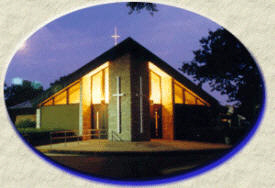 The dedication of the new church took place October 1, 1967 with our first worship service conducted on Sunday, August 27, 1967. With completion of the new church there were three main structures on the property; The sanctuary, the Christian Education building and the “church house” which was utilized for some Sunday School classes, church offices and special meetings. The house was extensively damaged by fire in 1972 and was subsequently razed.
The dedication of the new church took place October 1, 1967 with our first worship service conducted on Sunday, August 27, 1967. With completion of the new church there were three main structures on the property; The sanctuary, the Christian Education building and the “church house” which was utilized for some Sunday School classes, church offices and special meetings. The house was extensively damaged by fire in 1972 and was subsequently razed.
Mr. Richey’s resignation was accepted by the congregation on January 31, 1973. The pulpit was supplied by several temporary pastors, most notably the Rev. John Lyford and Rev. John Dzuro, during 1973.
 On January 6, 1974 the Session and congregation issued a pastoral call to the Rev. Joseph Stanley who was installed on February 27, 1974. Mr. Stanley’s resignation was accepted on January 1, 1989.
On January 6, 1974 the Session and congregation issued a pastoral call to the Rev. Joseph Stanley who was installed on February 27, 1974. Mr. Stanley’s resignation was accepted on January 1, 1989.
A new pipe organ was installed in January 1983 and dedicated on May 16 of that year. A detailed organ history follows:
In 1890, the first pipe organ was purchased at a cost of $1,500. In 1895, the first church was moved and remodeled, and a new sanctuary was erected on the corner of Church Street and Newberry Avenue. The first pipe organ served the church until December 26, 1926, when a new pipe organ was purchased at a cost of $4,600 plus the old organ. In 1967, this organ was rebuilt and installed at the present church site. Our present pipe organ, a Casavant Opus 3559, was completed in January of 1983 at a cost of $106,838. The instrument, designed, built and installed by Casavant Freres Limitee of St-Hyacinthe, Quebec, Canada, has 18 stops and 21 ranks of pipes, playing on two keyboards and pedals. The console is all-electric and detached from the organ. The stops and couplers are controlled by tilting tablets placed above the upper keyboard. The tilting tablets and combination thumb pistons are of rosewood. The manual natural keys are of maple, the sharps of ebony, and the pedal sharps of rose wood. The console case, the organist’s bench, and the pedal board are of oak and finished to match the surrounding woodwork. The organ is divided into three sections; Great, Swell, and Pedal, and is installed in the renovated organ chamber which houses 1044 pipes of natural metal finish of zinc, tin, lead and poplar wood. A blower providing wind which allows the pipes to “speak” or sound, is also located in the organ chamber. Each pipe in the organ was built and voiced to speak appropriately in the sound environment of the sanctuary. It took fourteen months to build, install, tune and voice the instrument.
 The Rev. Michael Orsted was installed as pastor of Pioneer Presbyterian Church on June 1, 1990. Mr. Orsted served for ten years, resigning on August 30, 2000.
The Rev. Michael Orsted was installed as pastor of Pioneer Presbyterian Church on June 1, 1990. Mr. Orsted served for ten years, resigning on August 30, 2000.
 The Rev. Jeannette Hickman became Pioneer’s interim pastor on Sunday, March 18, 2001. Pastor Hickman led Pioneer’s spiritual growth until August 2002 when she left to assume another Interim in Marshfield, Wisconsin.
The Rev. Jeannette Hickman became Pioneer’s interim pastor on Sunday, March 18, 2001. Pastor Hickman led Pioneer’s spiritual growth until August 2002 when she left to assume another Interim in Marshfield, Wisconsin.
 The Rev. Kathleen Dooley accepted Pioneer’s call and was installed as our pastor on October 13, 2002, serving until January 2007.
The Rev. Kathleen Dooley accepted Pioneer’s call and was installed as our pastor on October 13, 2002, serving until January 2007.
 The Rev. Craig Mansur served from 2007 until April 30, 2011 as interim pastor in addition to his responsibilities as Chaplin at Bay Area Medical Center.
The Rev. Craig Mansur served from 2007 until April 30, 2011 as interim pastor in addition to his responsibilities as Chaplin at Bay Area Medical Center.
 The Rev. Jon Nelson accepted a joint call from Pioneer Presbyterian and First Presbyterian in Menominee, MI to serve both congregations, effective May 1, 2011.
The Rev. Jon Nelson accepted a joint call from Pioneer Presbyterian and First Presbyterian in Menominee, MI to serve both congregations, effective May 1, 2011.
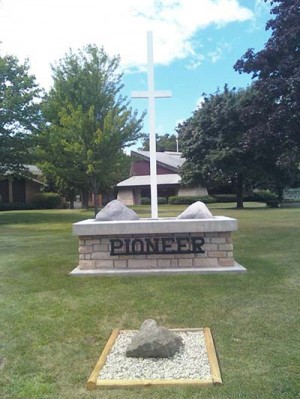 A new lighted entrance sign was dedicated August 12, 2012. Designed by Roy Peterson and constructed by Roy and Bob Landenberger, the sign was approved by the Memorial committee and funded by memorial gifts.
A new lighted entrance sign was dedicated August 12, 2012. Designed by Roy Peterson and constructed by Roy and Bob Landenberger, the sign was approved by the Memorial committee and funded by memorial gifts.